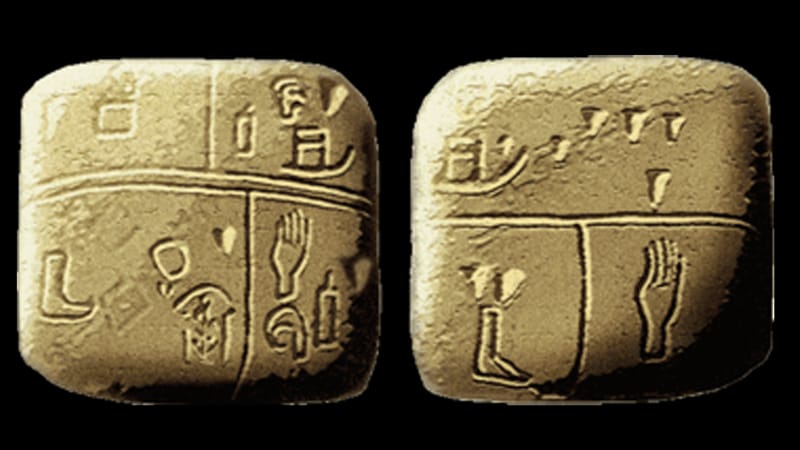Table of Contents
Psychologist Julian Jaynes regarded The Iliad and The Odyssey as works of literature that were pivotal in the evolution of the human mind. According to Jaynes’ The Origin of Consciousness in the Breakdown of the Bicameral Mind, full human consciousness emerged some time between the composition of the first work and the second.
But The Iliad, or even the Epic of Gilgamesh, are not in fact the oldest recorded human stories. Their stature, perhaps, remains unique, but humans have clearly been telling stories for a very long time – and writing them down almost as soon as they were able.
The Kish tablet is widely regarded as the oldest writing in the world that has been confirmed. Found in Iraq at the site of the ancient Sumerian city of Kish, the tablet has been dated to around 3500 BC. It’s not known what the Kish tablet actually says, but its handful of pictographs are unlikely to contain much in the way of complex story telling.

The oldest known stories (at least the ones preserved) took about another millennium to appear. The earliest ones are didactic in nature.
The Instructions Of Shuruppak, Sumerian, c 2500 BC
This ancient literature is a collection of lessons and sayings written by a father for Ziusudra, the hero of the Sumerian flood myth. The Instructions Of Shuruppak is perhaps the greatest example of Sumerian wisdom literature. It talks about dozens of helpful tips ranging from practical lessons to moral precepts to ensure Ziusudra would have a good life.
The Instructions of Shuruppak include such timeless lessons as “You should not commit rape on someone’s daughter” and “You should not have sex with your slave girl: she will chew you up” (clearly, humanity had along way to go, in 2500 BC), as well as more prosaic instructions like “You should not pass judgment when you drink beer.”
Thanks to the wisdom of Shuruppak, I also now know not to buy an onager. Crisis averted.
Not to be outdone in the wisdom-imparting stakes, about a century later the Egyptians got in on the act.
The Maxims Of Ptahhotep, Egyptian, c 2400 BC
This 18-page book of proverbs is a collection of the penned thoughts and ideas of Ptahhotep, an adviser for two different pharaohs, Menkauhor and Assa Djed-ka-Ra. Ptahhotep’s writings, much like The Instructions of Shuruppak, were presented as lessons for his son.
“The Maxims of Ptahhotep flows seamlessly between rules about civil obedience and social structure to those regarding personal relationships and sex.”
Poetics began to appear on the scene in the next few centuries.
The Lament For Ur, Sumerian, c 2000 BC
This is one of the earliest examples of poetic literature in the world. It is a dirge (a slow song that expresses sadness or sorrow) composed by the earliest kings of the Isin dynasty who wished to rebuild the destroyed city.
It took the Chinese over a millennium later to produce their oldest-known work of poetics.
Classic Of Poetry, Chinese, 1000–600 BC
Believed to have been compiled by the great philosopher Confucius, the Classic of Poetry (or Shijing), is the oldest existing book of poetry in the history of Chinese literature. The book is part of a group of five separate books, collectively called the Five Classics.
The book contains over 305 poems and divided into three distinct books: Feng (Songs), Ya (Odes and Epics) and Song (Hymns).
History, or at least, pseudo-history, also has a long history.
The Story Of Sinuhe, Egyptian, c 2000 BC
The Story Of Sinuhe is widely considered as Ancient Egypt’s greatest literary achievement. The story is set in the aftermath of the death of Pharaoh Amenemhat I, founder of Egypt’s 12th dynasty, in the early 20th century BC, and was most likely composed shortly after.
Egyptologists is still debating as to whether or not the story is based on actual events involving an individual named Sinuhe. The nature of the themes, including divine providence and mercy, makes Sinuhe most likely a work of fiction. Sinuhe’s anonymous author has been considered as the “Egyptian Shakespeare” whose ideas have parallels in biblical texts.
Other Egyptian works were also later echoed in the Bible.
The Ipuwer Papyrus, Egyptian, c 1650 BC
The Ipuwer Papyrus is believed to have been written by the eponymous 17th-century BC Egyptian. Originally called The Admonitions of an Egyptian Sage, this piece of ancient literature details the state of Egypt at a time when it was plunging into disarray, chronicling plagues raving the land and the Nile turning as red as blood, making its waters undrinkable.
The document’s true origin unfortunately can’t be determined since the Ipuwer Papyrus is but a copy of an older manuscript.
In short order, as well, fairy tales and folk stories were committed to writing for the first time.
The Poor Man Of Nippur, Akkadian, c 1500 BC
The Poor Man Of Nippur is one of the earliest examples of a folk tale. It is an Akkadian tale dating from around 1500 BC. It is a story about a man Gimil-Ninurta, so poor he lacks “even a change of clothing”.
Tale of Two Brothers, Egyptian, c 1185 BC
In 1857, the Tale of Two Brothers was sold to the British Museum where it was afterwards translated from the hieratic writing with which it was originally composed. It was written during or just slightly after the reign of Seti II, ruler of Egypt from 1200–1194 BC and is considered as the earliest example of a fairy tale. The papyrus’ exact date of discovery, however, remains unknown.
History Daily
You can read the Tale of Two Brothers here.
Then there is, of course, my personal favourites: the world’s oldest recorded jokes.
From Sumeria, 1900BC: Something which has never occurred since time immemorial; a young woman did not fart in her husband’s lap.
Three hundred years later, they were slaying ’em in the Egyptian comedy circuit with knee-slappers like this: How do you entertain a bored pharaoh? You sail a boatload of young women dressed only in fishing nets down the Nile and urge the pharaoh to go catch a fish.
The first recorded British joke, from the 10th century, has a suitably Carry-On flavour: What hangs at a man’s thigh and wants to poke the hole that it’s often poked before? A key.
Ooh, err, I say, Madam!









